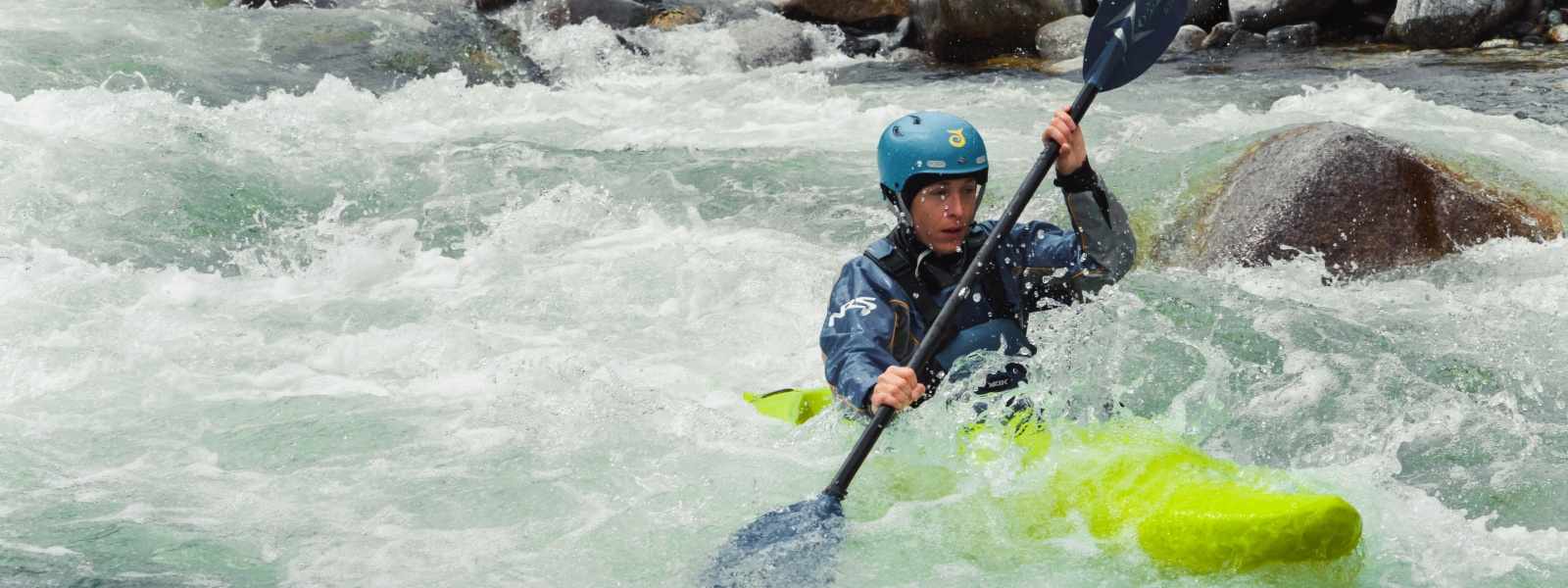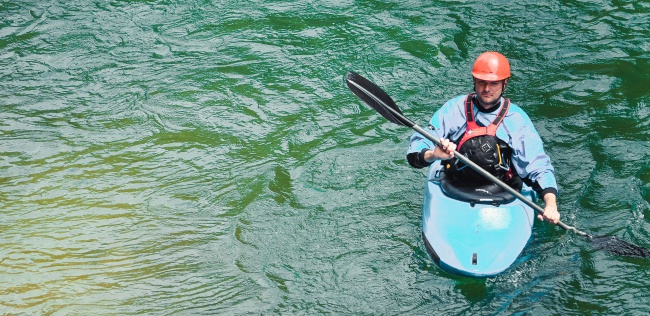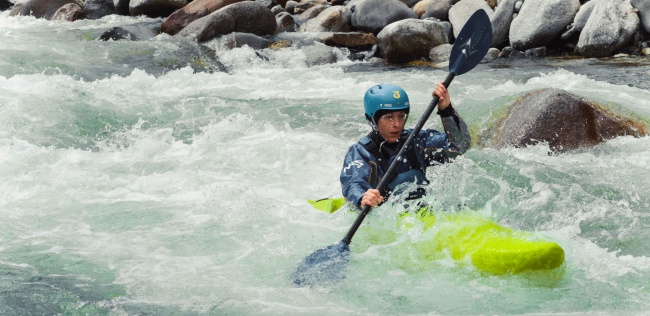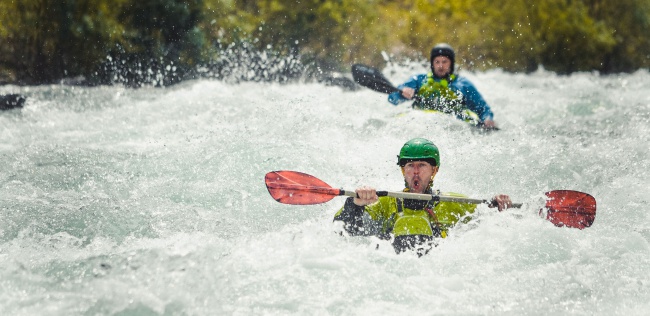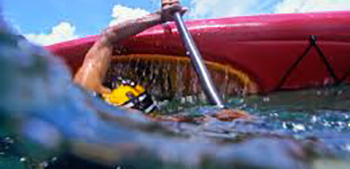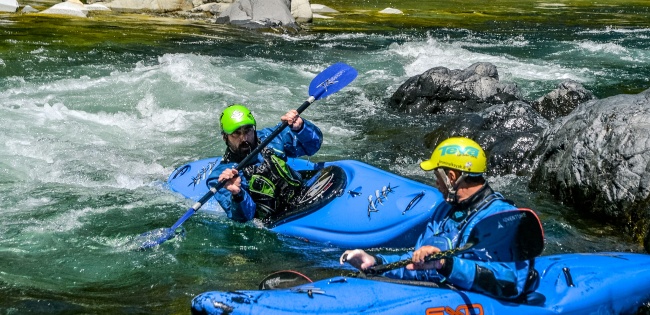Kayak Valsesia
White water kayaking is one of the most exciting and exhilarating that anyone can enjoy. White water kayaking demands a great deal of physical fitness, strength, stamina, and a lot of courage. White water kayaking enthusiasts thrive on the extreme thrill of sailing through fast-moving waters, only with their power and equipment taking them through the course safely and enjoyably.
The school supplies kayak, paddle and spraydeck, wetuits, helmet, life-jacket, waterproof jackets and transport to and from the river. Please bring a swimming suit, shoes that can get wet, a technical T-shirt and all that you need for the shower.
There are six levels, each one is referred to a "Grade" or "Class" followed by a number. The scale is not linear, nor fixed. For instance, there can be hard grade twos, easy grade threes, and so on. The grade of a river may change with the level of the flow. Often a river or rapid is given a numerical grade, and then a plus (+) or minus (-) to indicate if it is in the higher or lower end of the difficulty level. Also note that while a river section may be given an overall grading, it may contain sections above that grade, often noted as features, or conversely, it may contain sections of lower graded water as well. Details of portages may be given if these pose specific challenges.
Class I: Easy; small waves, clear passages; no serious obstacles.
Class II: Medium; rapids of moderate difficulty with clear passages; requires experience, more suitable outfit and boat.
Class III: Difficult ; numerous, high, irregular waves; rocks; eddies; rapids with clear passages though narrow, requiring expertise in maneuvering; scouting usually needed. Requires good operator and boat.
Class IV: Very difficult; long rapids; high, irregular waves; dangerous rocks; boiling eddies; best passages difficult to scout; scouting mandatory first time; powerful and precise maneuvering required. Demands expert boatman and excellent boat and good quality equipment.
Class V: Extremely difficult; exceedingly difficult, long and violent rapids, following each other almost without interruption; riverbed extremely obstructed; big drops; violent current; very steep gradient; close study essential but often difficult. Requires best person, boat, and outfit suited to the situation. All possible precautions must be taken.
Class VI Class U Formerly classified as unrunnable by any craft. This classification has now[when?] been redefined as "unraftable" due to people having recently kayaked multiple
Hystory of kayak
Kayaks were originally developed by indigenous people living in the Arctic regions, who used the boats to hunt on inland lakes, rivers and the coastal waters of the Arctic Ocean, North Atlantic, Bering Sea and North Pacific oceans. These first kayaks were constructed from stitched animal skins such as seal stretched over a wooden frame made from collected driftwood, as many of the areas of their construction were treeless. Archaeologists have found evidence indicating that kayaks are at least 4000 years old. The oldest still existing kayaks are exhibited in the North America department of the State Museum of Ethnology in Munich. Though the term "kayak" is now used broadly for this class of boat, native people made many different types of boat for different purposes. The baidarka developed by indigenous cultures in Alaska was also made in double or triple cockpit designs, and was used for hunting and transporting passengers or goods. An umiak is a large open sea canoe, ranging from 17 feet to 30 feet, made with seal skins and wood. It was originally paddled with single bladed paddles and typically had more than one paddler.
The word "kayak" means "man's boat" or "hunter's boat", and native kayaks were a very personal craft, built by the man who would use them (with assistance from his wife, who would sew the skins) fitting his measures, for maximum maneuverability. A special skin jacket, Tuilik, was then laced to the kayak, creating a waterproof seal. This made the eskimo roll the preferred method of regaining posture after turning upside down (from the kayaking point of view, it's not a capsize until you come out of the boat), especially as few Eskimos could swim; their waters are too cold for a swimmer to survive for very long.[2]
The modern version of a tuilik is a spraydeck made of waterproof synthetic stretchy enough to fit tightly around the cockpit rim and body of the kayaker, which can however be released rapidly from the cockpit to permit easy exit from the boat.
The builder used found materials and anthropomorphic measurements, using his own body, to create a kayak conforming closely to his own body. For example: the length was typically three times the span of his outstretched arms. Most of the Eskimo peoples from the Aleutian Island eastward to Greenland relied on the kayak for hunting a variety of prey — primarily seals, though whales and caribou were important in some areas. Skin on frame kayaks are still being used for hunting by Inuit people in Greenland. In other parts of the world homebuilders are continuing the tradition of skin on frame kayaks albeit with modern skins of canvas or synthetic fabric.
Contemporary kayaks trace their origins primarily to the native boats of Alaska, northern Canada, and Southwest Greenland. Wooden kayaks and fabric kayaks on wooden frames (such as the Klepper) dominated the market up until 1950s, when fiberglass boats were first introduced. Rotomolded plastic kayaks first appeared in 1973. The development of plastic kayaks arguably initiated the developed of freestyle kayaking as we see it today, since plastic boats could be made smaller, stronger and more resilient than those made of other materials.

